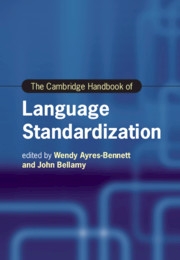Book contents
- The Cambridge Handbook of Language Standardization
- cambridge handbooks in language and linguistics
- The Cambridge Handbook of Language Standardization
- Copyright page
- Contents
- Figures
- Tables
- Contributors
- Introduction
- Part I Revisiting Models and Theories of Language Standardization
- Part II Legitimacy, Authority and the Written Form
- 7 Standard Languages in the Context of Language Policy and Planning and Language Rights
- 8 State-Appointed Institutions
- 9 Grammars, Dictionaries and Other Metalinguistic Texts in the Context of Language Standardization
- 10 An Industry Perspective
- 11 The Role of Literature in Language Standardization
- 12 Standardization, New Speakers and the Acceptance of (New) Standards
- 13 Creoles and Variation
- Part III Norms, Literacy and Education
- Part IV Beyond the National
- Part V Standardization in Late Modernity
- Name Index
- Subject Index
- References
9 - Grammars, Dictionaries and Other Metalinguistic Texts in the Context of Language Standardization
from Part II - Legitimacy, Authority and the Written Form
Published online by Cambridge University Press: 01 July 2021
- The Cambridge Handbook of Language Standardization
- cambridge handbooks in language and linguistics
- The Cambridge Handbook of Language Standardization
- Copyright page
- Contents
- Figures
- Tables
- Contributors
- Introduction
- Part I Revisiting Models and Theories of Language Standardization
- Part II Legitimacy, Authority and the Written Form
- 7 Standard Languages in the Context of Language Policy and Planning and Language Rights
- 8 State-Appointed Institutions
- 9 Grammars, Dictionaries and Other Metalinguistic Texts in the Context of Language Standardization
- 10 An Industry Perspective
- 11 The Role of Literature in Language Standardization
- 12 Standardization, New Speakers and the Acceptance of (New) Standards
- 13 Creoles and Variation
- Part III Norms, Literacy and Education
- Part IV Beyond the National
- Part V Standardization in Late Modernity
- Name Index
- Subject Index
- References
Summary
This chapter analyses the role of grammars, dictionaries and other metalinguistic texts in the history and present practice of language standardization, with examples and case studies taken from a broad range of European and non-European languages. The chapter presents a typology of codification types, with examples: standard-creating, modernizing, archaizing and standard-descriptive. It argues that dictionaries, grammars and related texts participate in a historical discourse tradition, with a number of shared features, but where participation in that discourse tradition does not necessarily indicate the presence of a standard language ideology. It presents that discourse tradition in five broad (and inevitably sometimes overlapping) phases: early practical (professional or pedagogical) codifications; patriotic codifications (from the sixteenth century onwards in Europe); public-orientated codifications (rationalist, democratizing codifications, with a wider intended reach, from the late eighteenth century); national and nationalist codifications; and post-national(ist) challenges to standard ideologies. It also looks at the important role of grammars and dictionaries for foreign language learners in the history of language standardizations and the connections to language purism. Finally, the chapter presents a framework to evaluate the difficult question of the authority, reach and ultimate influence of grammars, dictionaries and related texts on usage.
Keywords
- Type
- Chapter
- Information
- The Cambridge Handbook of Language Standardization , pp. 263 - 293Publisher: Cambridge University PressPrint publication year: 2021
References
- 4
- Cited by



